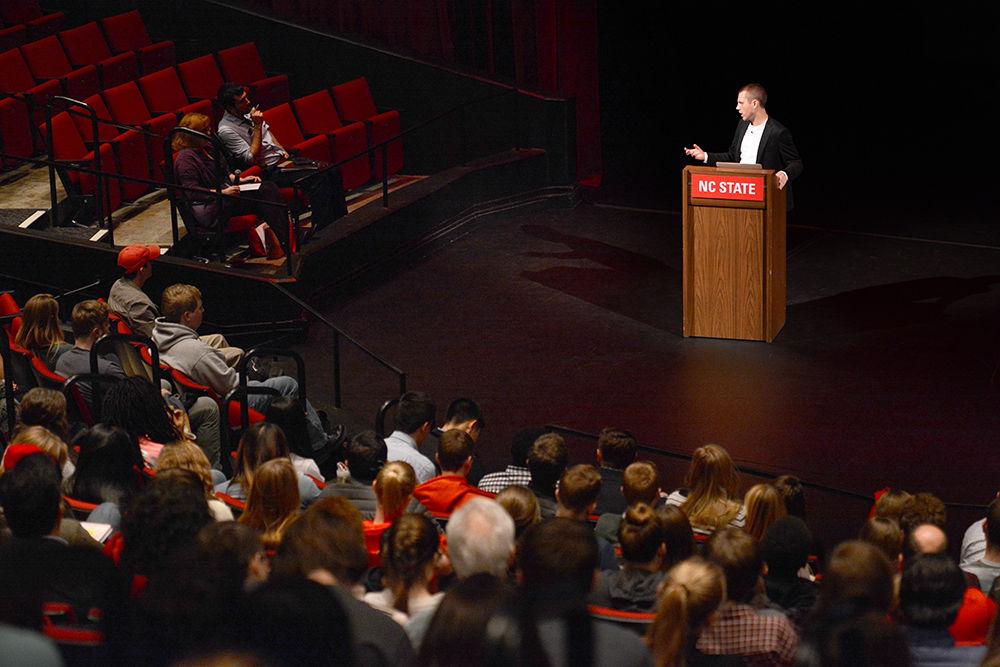Computer scientist Skylar Tibbits came to Stewart Theatre on Monday night to discuss the future of 3-D printing, materials science, self-assembling objects and many other technologies that he calls “4-D technology”. The talk included an overview of how software has created the field he occupies at his Self-Assembly Laboratory at the Massachusetts Institute of Technology.
“It’s without question that software radically changed how we approached design,” Tibbits said.
Tibbits pointed to an imbalance between the sophistication of design tools and the lack of refinement in manufacturing. He claims that 4-D technology has the propensity to make up the difference.
“Less cost, less time … that’s what we’re trying to do with 4-D printing,” Tibbits said.
Throughout the presentation, Tibbits presented many of the research artifacts created at the Self-Assembly Lab at MIT. He included videos demonstrating a self-assembling chair made up of six components that all eventually came together when randomly propelled through a small aquarium. Another video showed a prototype of two self-assembling phones, each made from three parts that come together when tumbled in a cement mixer.
Most of the folding materials presented by Tibbits are activated by water, using materials whose properties change when in contact with water.
“We’ve printed all sorts of structures that can go from one shape to another … You put them underwater and they can fold into something else,” Tibbits said. “It transforms without any sort of traditional energy.”
The Self-Assembly Lab was presented with a challenge when they found companies wanting to 3-D print with materials other than the usual plastics. This led researchers in the lab to look into unusual materials to print, including wood mixed with plastic.
“We literally print wood,” Tibbits said.
Tibbits says that the properties that make wood “smart” have long been neglected in everyday applications, and illustrated how moisture could be used to cause wood to fold in predictable ways.
Among the companies the lab has collaborated with is Google and Airbus. For Google, the lab built transformable structures to allow for private meetings in an open-office setting. The structures allow for audible and visual isolation without the need for a whole room to be constructed. For Airbus, the lab worked on a mechanism to control airflow to the engines of planes. Using electronically controlled flaps for this purpose introduces the possibility of error in the electronic systems, so the lab developed carbon fiber flaps that react to pressure differentials and appropriately fold open or closed based on the plane’s elevation.
As the presentation came to a close, Tibbits stated the motif he hoped to present throughout the name.
“Today we program computers and machines, tomorrow we will program matter itself,” Tibbits said.
During the question and answer session, Tibbits highlighted the difficulty of innovating as a career.
“Every day we fail 90 percent of the time … but what I’m trying to find that 10 percent of the time that it works and you’re lucky,” Tibbits said.
He also proposed that the STEM fields might benefit from the inclusion of arts. Tibbits’ work has been exhibited at the Solomon R. Guggenheim Museum in New York, and he takes the view that creating work that belongs in such a setting is important to fostering an innovative environment.
“I really believe in the initiative of turning STEM into STEAM, and including the arts,” Tibbits said. “It’s not just about looking beautiful … but it’s also about how you think. I think we need to tap into the art and design part of the brain to think differently.”
Aubrey Knier, a freshman studying art and design, said she appreciated this message of bringing the arts into STEM.
“I really appreciated that because I’m an artist, too,” Knier said. “I’m always trying to integrate science and art together, so I appreciated what he said.”
The audience contained members outside of the NC State community, as well. Eric Amico, a junior at Chapel Hill High School came after he heard about the event through his computer engineering teacher.
“This is the type of stuff I’m interested in,” Amico said. “What I thought was really cool was his idea of transforming shoes. Things that transform depending on the environment, I thought that was really cool.”
When asked about when in his academic career he realized that his research he is doing now is what he wanted to do, Tibbits explained that he’s still on a search for what he wants to be researching.
“I still don’t know this is the research I want to be doing … it’s always this search,” Tibbits said. “It’s more like: what are you passionate about?”
When asked to give advice to the largely undergraduate crowd, he told the audience to pave its own educational path.
“It’s not about a degree, and it’s not about a field,” Tibbits said. “I’m more and more about breaking away from those silos … I think it’s much more interesting to find your own weird navigation across those things. What you’re trying to do is break your own history and legacy. Break the repetitive nature of what you already do. At every stage, it’s like what are other people not doing?”
Michaela Bate, a senior studying civil engineering, said that the message of defining your own education resonated with her.
“I think already am starting to do that,” Bate said. “It was encouragement that I’m making the right choices and switching majors, and not getting too honed-in on just getting the grades and trying to get a degree … It’s just a reminder to keep a broad perspective.”
Bate says that this is a message from the talk that she would like to emphasize.
“I encourage people to think bigger,” Bate said. “Use more than just their one discipline, and seek hobbies that they really enjoy and not focus too much on school.”








